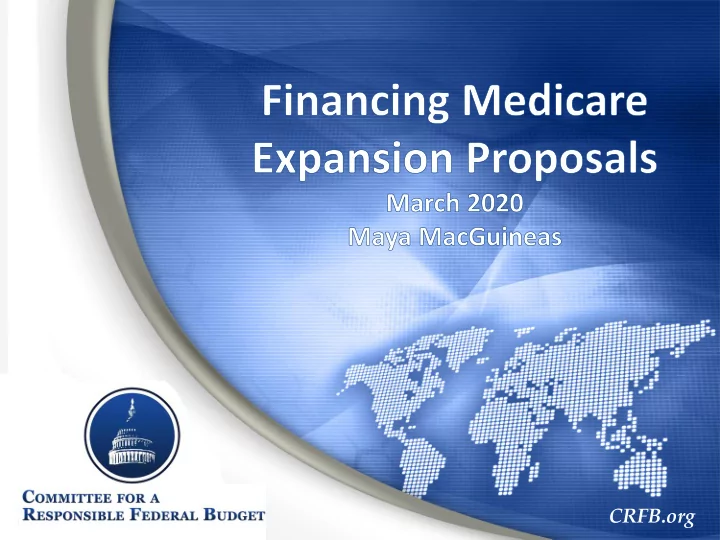

CRFB.org
Types of Medicare Expansion Medicare Buy-In/Eligibility Change A Public Option (Medicare for Some) Medicare for All (Comprehensive Single-Payer) CRFB.org
How Much Would Medicare for All Cost? Depends on what you mean by “cost” Medicare for All would increase federal costs dramatically • Eliminating premiums and out-of-pocket costs would transfer significant new costs to the federal government • Expanding coverage to more people and for more services would further increase costs • Lower provider payments, drug prices, and administrative costs would partially offset increase Medicare for All could increase or reduce national health expenditures • Expanding coverage and reducing cost sharing would increase utilization and thus cost of care • Paying less for medical providers, prescription drugs, and administrative spending would reduce costs The effect on federal costs and national health expenditures are BOTH important • Higher NHE means a larger share of the economy’s resources going to health care • Higher federal costs requires great levels of taxes, spending cuts, or borrowing – different financing choices have different economic, distributional, and policy consequences CRFB.org
Medicare for All Would Cost About $30 Trillion Trillions of Dollars Over Ten Years (Windows Vary) $40 $36T $34T $32T $29T $30 $28T $27T $25T $20 $14T $10 $0 PERI Thorpe Blahous Blahous Urban Center for Sanders Warren (Low) (High) Institute Health & (CRFB) (CRFB) (2019) Economy Sources: PERI, Kenneth Thorpe, Charles Blahous, Urban Institute, and Center for Health and Economy. Note: ten-year costs are estimated on different budget windows, some include revenue CRFB.org feedback while others do not, and some include long-term care while others do not.
Many Options for Financing Medicare for All Generating $30 trillion would require the equivalent of: • A 32 percent payroll tax on all wages; • A 25 percent income surtax on income above $24,800; • A 42 percent value added tax (VAT); • A mandatory public premium of $7,500 per capita or $12,000 per individual without public insurance; • More than doubling all individual and corporate tax rates; • An 80 percent reduction in non-health federal spending; • A 105 percent of GDP increase in the national debt; OR • Impossibly high taxes on high earners, corporations, and the financial sector Policymakers would likely consider a combination of approaches Source: Committee for a Responsible Federal Budget. CRFB.org
Options Have Different Distributional Implications Nominal Dollars $60,000 $50,000 Medicare for All Benefits Impose Public Premium Impose New Payroll Tax $40,000 Impose VAT Impose Income Surtax $30,000 Double Income Tax Rates $20,000 $10,000 $0 Bottom 2nd Middle 4th Top Source: CRFB calculations based on Urban Institute methodology. Note: analysis is preliminary. CRFB.org
Options Have Different Economic Implications Financed with Payroll Tax Financed with Deficit Financed with Premiums GDP Hours Worked GDP Hours Worked GDP Hours Worked 0% -2% -2.3% $2,100 per person -4% -6% -5.9% $5,300 per person -7% -7.3% -8% 10 million FTEs $6,500 per person -10% -9.9% 14 million FTEs -12% -12.2% 17 million FTEs -14% Percent Change in 2030 Source: CRFB calculations based on Penn Wharton Budget Model and CBO data. CRFB.org
Options Have Different Tax Capacity Implications Top Marginal Tax Rate 100% IMPOSSIBLE 84.6% 80% State/Local Taxes 72.7% Payroll Taxes 68.8% Estimated Revenue- State/Local Taxes Maximizing Rates* State/Local Taxes Payroll Taxes 60% 48.1% Payroll Taxes State/Local Taxes 40% Payroll Taxes Income Taxes Income Taxes 20% Income Taxes Income Taxes 0% Current Law 32% Payroll Tax 25% Income Double Income Tax High Earners Surtax Tax Rates Only Source: CRFB estimates. Note: includes interaction effects. *Revenue-maximizing rates have been CRFB.org estimated at 63 percent by Trabrandt and Uhlig and 73 percent by Diamond and Saez.
2020 Candidates All Propose Different Pay-Fors Trillions of Dollars in New Spending and Offsets, Central Estimate, 2021-2030 $2.25 $2.25 Biden Biden $1.45 Biden $1.45 Biden $2.85 Buttigieg Buttigieg $3.3 $2.85 $0.0 $0.5 $1.0 $1.5 $2.0 $2.5 $3.0 $3.5 Buttigieg $3.3 Buttigieg $30.6 Sanders $17.65 Sanders $31.75 Warren $25.65 Warren $0 $5 $10 $15 $20 $25 $30 $35 Gross Cost Cost Reduction Direct Offsets Additional Offsets CRFB.org Source: Committee for a Responsible Federal Budget.
What Else Could You Do With The Money? Things you could do with $800 billion: Free Public College & Universal Pre-K Double the Earned Income Tax Credit Paid Family Leave & Debt-Free College Double the NIH Research Budget & Fund the Highway Trust Fund More Than Double SNAP Spending Things you could do with $30 trillion: Triple All Social Security Spending Quintuple Defense Spending Launch the Apollo Program 200 Times Abolish the Individual & Corporate Income Tax Enact a Universal Basic Income of $1,000 per month CRFB.org
Recommend
More recommend